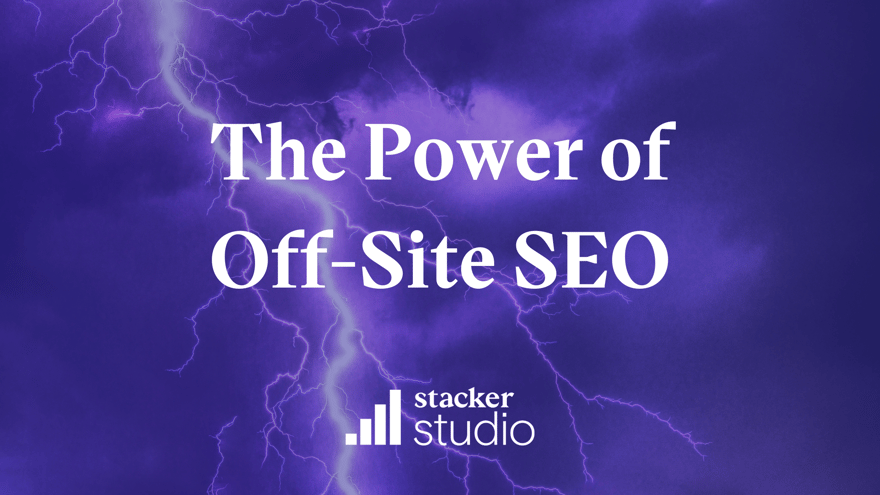Stacker believes that the chief difficulty most marketing or SEO programs face is not a lack of tactics, but a gap in their larger-scale strategy.
We’ve seen too many SEO programs enthusiastically tackle technical and content improvements but then realize that all of their work has gone unnoticed, because they’re still unable to rank with these efforts alone.
Our mission is to fill that gap, so here’s a breakdown of what we do to help brands improve their off-site SEO and the guiding beliefs behind our approach.
Belief #1: Technical SEO, on-site content strategy, and off-site SEO are ALL crucial, necessary components to achieve organic growth.
There is no one-trick pony in organic traffic growth. If someone tells you there is, don’t buy what they’re selling (figuratively and literally).
Way too many elements are at play for one tactic to fundamentally change your business. Google uses more than 200 ranking factors to assess which pages should rank highest for each query, which are divided into the “three pillars” of SEO:
- Technical SEO
- Content and on-page SEO
- Off-site SEO (AKA off-page SEO) / authority building
This is why you need a three-pronged approach that addresses each of these core SEO needs. At Stacker Studio, we help brand partners with earning authority signals (like brand mentions, follow links, canonicals, etc.), which means our best-performing partners have already invested in the other elements of technical and on-site content.
Let’s take a look at how these pillars work together.
Pillar 1: Technical SEO
You have to make sure your site is technically well set up and maintained. Can Google accurately crawl your site? Are your pages loading quickly enough for mobile users? There are a hundred other questions that fall into technical SEO and make a huge impact on how people and search engines interact with your site.
Ensuring that a site has the proper technical fundamentals is the first step to any holistic SEO program, and these fundamentals must be monitored and maintained throughout the site’s lifespan.
Pillar 2: On-site content/SEO
You have to create content on your site that deserves to be ranked. You can earn high rankings by building out resources that genuinely help answer the questions of searchers. The question of how to create rankable content is too large to go into in this article, but here’s a recommended resource to explore it more in depth.
It’s critical to give this component a lot of your attention and resources, because hundreds or thousands of pages are competing for the same keyword in search engines. If Google’s goal is to rank the page that best answers the user’s question, then you have to have content that deserves that distinction.
In addition to content fundamentals, you also need to ensure your on-page SEO fundamentals (things like title tags, keyword targeting in H1s, image alt text, etc.) are also optimized in accordance with your strategy.
Pillar 3: Off-site SEO
You have to demonstrate your authority. One of the core ways Google determines authority is to see what other websites are linking to yours. If a highly respected, trusted site links to your website, it signals you’re likely to know what you’re talking about.
Source: Search Engine Journal with Stacker annotations
All of these elements together — building the technical foundation, creating high-quality content on that foundation, and then earning authority signals to your site by getting it mentioned or republished elsewhere — are critical for a successful SEO program. If you don’t invest in all three of these SEO elements, you’re not giving yourself a fair shot at sustainably growing your organic traffic.
Belief #2: High-quality earned media provides impactful authority signals.
Like we mentioned earlier, we help brands with the third pillar of SEO strategy: off-site/off-page SEO and authority building.
While there are many ways a brand can build authority, we’ve seen that media mentions can provide a significant authority boost.
There are a couple of reasons for this. First, if you’re earning a brand mention (meaning you didn’t pay for it), that means you provided something quite newsworthy and interesting to the publisher’s audience. In rare instances, this can be about the company and its products/services.
Source: TechCrunch
But company updates are often not enough to garner ongoing media attention. In order to earn media on a regular basis, you have to create something capable of breaking through the noise of journalists’ inboxes.
In fact, in Q1 2022, journalists only responded to an average of 3.37% of the pitch emails they received.
This is why we decided to start working with brands — we knew folks specializing in marketing, SEO, and/or growth were interested in continuously earning media coverage for a variety of reasons (which we’ll explain shortly).
However, the brands we work with have to understand the value of tangential content, or content that’s “zoomed out” and about a topic relevant to a brand’s industry (and not its core product or service). This type of content has a much wider appeal, making it more likely to be picked up by news sites.
As an example, for Pyn, we created a piece for them called The most important well-being programs, according to workers. We sent it out through our newswire and it got picked up 300+ times.
Source: SFGate
Brands like Pyn partner with us because they understand the value of creating content that earns media to supplement the other earned media they get about their business. They know these are powerful authority signals.
The second reason earned media is a powerful authority signal is because of the links and canonicals associated with these types of pickups. You can see in the SFGate example above how the article links to Pyn’s site. When news sites like SFGate link to a site, it shows that the site is a trusted source of information.
In our case, a canonical is also used, because the articles are frequently republished entirely. When duplicate articles exist online, canonicals help Google understand which article is the original. Pyn had the canonical for this series, so Google can tell that SFGate chose to republish it in full. This, in itself, is also an authority signal, because sites typically wouldn’t republish a piece of content they didn’t trust.
Source: SFGate article code
This combination of rel=canonical tag pointing to a client’s site and an in-text dofollow pointing to the client’s site provides search engines with powerful SEO authority signals, improving authority metrics like domain rating (DR) / domain authority (DA) and increasing organic performance over time.
Finally, brands mentioned in the media can build trust with readers. Studies have shown that “repeated exposure to a brand will lead to an increased likelihood of selecting that brand.” Not only are readers seeing a mention of a brand partner’s name, but it’s in the context of being included in an article from a trustworthy news site.
When Pyn’s stories are picked up across 200 sites, readers in towns all across North America are seeing their brand name.
Belief #3: Brand authority will continue to increase in importance.
Google wants to know if you’re authoritative before it ranks your pages highly in search results. Readers want to know you’re authoritative before trusting your advice or spending their money on your products or services.
In order to improve the quality of the search engine results pages (SERPs), Google is constantly trying to assess authority. If you work in SEO, you’ve probably heard the acronym E-A-T, which stands for expertise, authoritativeness, and trustworthiness. (Of course, now it's E-E-A-T, but that's a conversation for another time.)
Source: Google’s Search Quality Guidelines
Our goal is to help your website and brand earn authority and trust. We do this by creating high-quality content on your behalf and distributing it to top-tier news publications across North America. When hundreds of them elect to publish your content and link to your website, that sends a very strong authority signal to search engines that your site is authoritative and trustworthy.
But authority is critical for the actual user, too.
“72 percent of consumers say relevant content delivered at the right time and place boosts their trust…Providing creative and interesting content is also one of the top ways brands can demonstrate empathy for customers.” - 2022 Trust Report: Customer trust is earned or broken with every experience
Authority often leads to trust, which often leads to more revenue.
“Consumers who trust a brand are more than twice as likely to be the first to buy the brand’s new products (53 percent versus 25 percent). They are more than twice as likely to stay loyal to a brand they trust, even in the face of disruption, such as a trendy or innovative competitor (62 percent versus 29 percent).” - 2019 Edelman Trust Barometer Special Report
Ultimately, authority is critical to ranking in search engines, which is why SEOs have placed so much importance on off-site SEO for years and will continue to do so.
Source: Aira’s The State of Link Building Report 2022
And as the content landscape changes with innovations like AI content generation, it’s likely that search engines’ reliance on “un-automatable” signals (like relationships with journalists and other publishers) will become higher than ever.
By ensuring that your domain is featured across a large number of the major news publications in the country, you gain a foundation of trust that can’t easily be replicated.
The Results
No amount of theory will replace real-world results, which is why Stacker’s SEO team continually monitors client performance to ensure that our methods work well.
A case study of Stacker’s full client profile found significant improvement across all metrics measured at the 180-day mark after pairing with Stacker:
.png?width=618&height=856&name=180%20case%20study%20table%20(1).png)
If you have any questions about our approach, please don’t hesitate to contact us. Our goal is to be as transparent as possible (unsurprisingly, that also helps build authority).
And if you’re like-minded in how you approach growth, we’d love to partner with you.





.jpg?width=1657&height=1000&name=Nav-Our%20Results(1).jpg)




